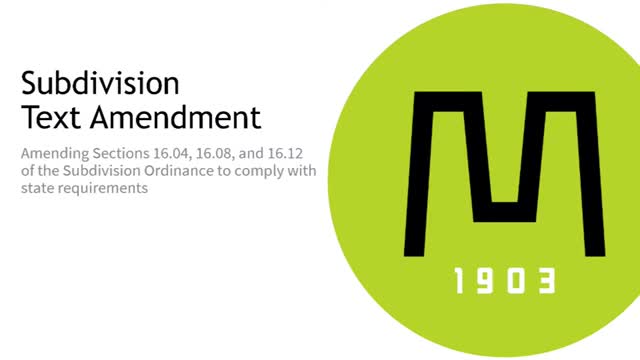City Council Approves Controversial Subdivision Ordinance Changes
January 16, 2024 | Murray , Salt Lake County, Utah

This article was created by AI summarizing key points discussed. AI makes mistakes, so for full details and context, please refer to the video of the full meeting. Please report any errors so we can fix them. Report an error »

In a recent city council meeting, officials discussed a significant amendment to the subdivision ordinance aimed at aligning local regulations with new state requirements outlined in Senate Bill 174. This legislation mandates a streamlined public process for subdivision approvals, reflecting a broader effort to address the housing crisis affecting Utah and the nation.
The proposed changes will reduce the number of public hearings required for subdivision approvals from four to one, with the Planning Commission handling most reviews. Under the new framework, applicants must submit their proposals to the Planning Commission within 15 business days, and the final subdivision review will be conducted internally by city staff without public hearings. This shift is intended to expedite the approval process while still allowing for public input during the initial stages.
City officials acknowledged the challenges posed by the new state law, particularly the limitations it places on local governance. Council members expressed concerns about the reduced public engagement, with some advocating for broader notification practices to ensure community members are informed about developments in their neighborhoods. Suggestions included extending notification distances beyond the current 300 to 500 feet radius.
During the public comment period, residents voiced mixed opinions. Some supported the expedited process, emphasizing the need for efficiency in planning, while others raised concerns about potential safety risks and the importance of thorough reviews, including soil and water analyses. One resident highlighted the need for the city to maintain its autonomy in planning decisions, criticizing state interference in local governance.
Ultimately, the council voted to approve the ordinance amendments, with a 4 to 1 majority. The decision reflects a commitment to comply with state mandates while navigating the complexities of local development needs and community engagement. The council's actions underscore the ongoing tension between state legislation and local governance, particularly in rapidly growing areas like Murray.
The proposed changes will reduce the number of public hearings required for subdivision approvals from four to one, with the Planning Commission handling most reviews. Under the new framework, applicants must submit their proposals to the Planning Commission within 15 business days, and the final subdivision review will be conducted internally by city staff without public hearings. This shift is intended to expedite the approval process while still allowing for public input during the initial stages.
City officials acknowledged the challenges posed by the new state law, particularly the limitations it places on local governance. Council members expressed concerns about the reduced public engagement, with some advocating for broader notification practices to ensure community members are informed about developments in their neighborhoods. Suggestions included extending notification distances beyond the current 300 to 500 feet radius.
During the public comment period, residents voiced mixed opinions. Some supported the expedited process, emphasizing the need for efficiency in planning, while others raised concerns about potential safety risks and the importance of thorough reviews, including soil and water analyses. One resident highlighted the need for the city to maintain its autonomy in planning decisions, criticizing state interference in local governance.
Ultimately, the council voted to approve the ordinance amendments, with a 4 to 1 majority. The decision reflects a commitment to comply with state mandates while navigating the complexities of local development needs and community engagement. The council's actions underscore the ongoing tension between state legislation and local governance, particularly in rapidly growing areas like Murray.
View full meeting
This article is based on a recent meeting—watch the full video and explore the complete transcript for deeper insights into the discussion.
View full meeting

